Back to the 50's and 60's!
Don't Be Cruel
Love Me Tender
Heartbreak Hotel
Doin' The Best I Can
UPDATE:
Bush Takes Japanese Prime Minister Junichiro Koizumi to Graceland for Tour of Elvis' Home
Friday, June 30, 2006
Marty Robbins - Courtesy of YouTube
Up there with eternal favorite, Elvis Presley, is country singer, Marty Robbins, with the unequalled and un-imitated dulcet voice. Give a listen!
Singing The Blues
A White Sport Coat
El Paso
Singing The Blues
A White Sport Coat
El Paso
A Layman Looks At Site Visits Data Of Popular Political Blogs
The figures tallied by blog metering/tracking sites such as the very popular Site Meter may have unknowingly faced some mute challenges or doubts from certain quarters at times past with regard to their numbers' accuracy and authenticity. But most of these doubts might have been erroneously premised based on a lack of understanding of the data being counted. Thus, to this day nothing has really been publicly exposed to show that those figures as reflected in most blog sites do not really accurately reflect what they are supposed to show, whether as visits/unique visits, or page views. Thus, for all intents and purposes, these numbers reflect actual visits to the blogs.
Lately, this stubborn issue has expectedly re-emerged because of the boiling controversy over the alleged Kosola which targets Markos of DailyKos on his close relationships with buddy Jerome Armstrong. Some commenters in the different sites which have been blogging about this have advanced some rhetoric aimed at challenging the authenticity of the numbers as shown for DailyKos readers, which site is typically described as having at least 500K readers on a daily basis. Without question based on its numbers, it is the most widely-visited site in the entire blogosphere. And the other blogs individually, whether on the right or left of the political spectrum, have not even come close to the liberal-oriented Daily Kos’ numbers. Thus, on the right side, we have such sites as Michelle Malkin, Powerline, Instapundit, and Little Green Footballs, individually registering only in the low 100Ks or even less.
DailyKos actually works more like a collective endeavor whereby an elite select group, including site founder/owner Markos, blogs for the homepage, at times called the frontpagers, and hundreds or thousands of registered members blog on site under their own diaries; while those on the right mentioned above are essentially one-man/women operations, except for Powerline where three lawyers alternately blog on the site.
All the above-named sites use Site Meter and allow third parties to access their statistics. It is good to note that other sites, whether using also Site Meter or some other metering application keep similar statistics private.
DailyKos, Michelle Malkin, Instapundit, and Little Green Footballs
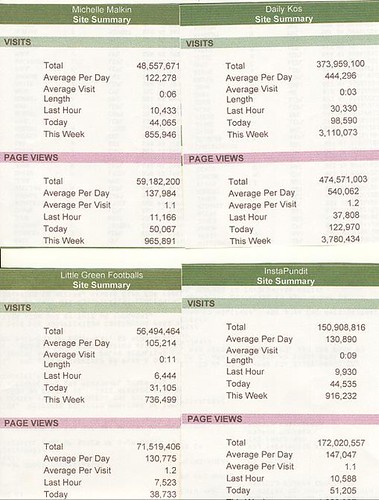
Powerline
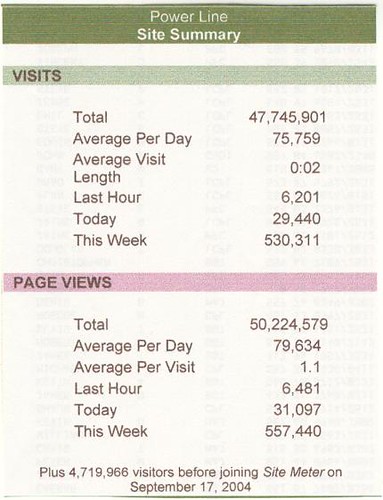
Visit Detail From DailyKos
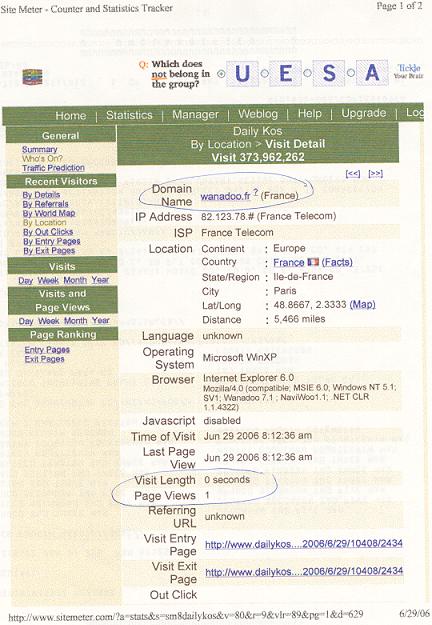
To put in a better light the figures tallied on the above graphics, it may serve us well to find out first what and how Site Meter collects data.
Here is some pertinent information from its site:
Some personal observations:
1. It appears clear that page view stats are more significant than visits because they tend to give more information about the visitor and what he did on site, his human actions as opposed to those initiated by machines or applications (browser and server, or robots and spiders). And if the visitor views more than one page, we also get a good estimate of his length of stay in the site.
2. We can also discern why under Visit Detail, the Visit Length usually shows zero time. And it is because Site Meter cannot record a visit’s length if the visitor stays only on one page and leaves.
3. We have also learned that visitors from all over the world are recorded. Thus the more popular the blog, one could surmise, the more foreign visitors are recorded.
4. All summaries show that page views per visit averages only 1 and a fraction. In other words, the typical visit views only one page and then some. Since I assume that one can only view a full page and not a portion of it, a good number of visitors view more than one page of the blog.
5. With Site Meter one significant detail about visit increments is that one visitor is given “no more ohan 30 minutes between page views”. A single visitor who spends multiple hours in one internet session could be recorded more than once, if he visits one site multiple times, and allows more than 30 minutes between visits. This applies to Site Meter patrons, but other tracking services may have longer time limits, or may be more discerning and discriminating such as defining characteristics of unique visitors.
6. Now, compare the above to a couple of sites, one receiving under 300 visits a day and the other only 16 visits a day.
The Ignatian Perspective and Philippine Commentary
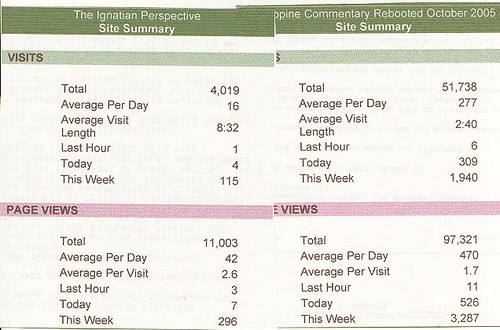
Average visit length of The Ignatian Perspective is pegged at 8:32 minutes, with 2.6 page views per visit. Philippine Commentary with 277 daily visitors registered an average visit length of 2:40 minutes and 1.7 page views per visit. Yet as recorded, average visit length for DailyKos is a miniscule three seconds and not much better for the rest highlighted above. It is clearly evident that huge numbers of visitors can bring this particular stat to a very low number, taking into account the wide variances in visiting habits of hordes of readers.
Lately, this stubborn issue has expectedly re-emerged because of the boiling controversy over the alleged Kosola which targets Markos of DailyKos on his close relationships with buddy Jerome Armstrong. Some commenters in the different sites which have been blogging about this have advanced some rhetoric aimed at challenging the authenticity of the numbers as shown for DailyKos readers, which site is typically described as having at least 500K readers on a daily basis. Without question based on its numbers, it is the most widely-visited site in the entire blogosphere. And the other blogs individually, whether on the right or left of the political spectrum, have not even come close to the liberal-oriented Daily Kos’ numbers. Thus, on the right side, we have such sites as Michelle Malkin, Powerline, Instapundit, and Little Green Footballs, individually registering only in the low 100Ks or even less.
DailyKos actually works more like a collective endeavor whereby an elite select group, including site founder/owner Markos, blogs for the homepage, at times called the frontpagers, and hundreds or thousands of registered members blog on site under their own diaries; while those on the right mentioned above are essentially one-man/women operations, except for Powerline where three lawyers alternately blog on the site.
All the above-named sites use Site Meter and allow third parties to access their statistics. It is good to note that other sites, whether using also Site Meter or some other metering application keep similar statistics private.
DailyKos, Michelle Malkin, Instapundit, and Little Green Footballs

Powerline

Visit Detail From DailyKos

To put in a better light the figures tallied on the above graphics, it may serve us well to find out first what and how Site Meter collects data.
Here is some pertinent information from its site:
What is Site Meter tracking exactly?
Site Meter tracks page views and visits. You may also have heard the term "hits". When someone comes to your site, they generate a "hit" for every piece of content that is sent to their computer. Viewing a single web site page would generate one hit for the page and one hit for every individual graphics file that was on the page. A single page could easily generate a dozen or more hits. When you are browsing a site, every time you follow a link, it is treated as a single "page view". Site Meter defines a "visit" as a series of page views by one person with no more than 30 minutes in between page views.
Why do some of my visitors have visit lengths of 0:00?
That means the visitors are only staying to view a single page and then leaving. The only way that Site Meter knows how long someone is on a site is by the times of each page view. If they only look at a single page and then leave, we don't know how long they looked at the page. If they looked at two pages and left we would know they at least were on the site during the time of the first page view and the second page view. The difference between those two times would be the length of the visit.
What is the difference between a visit and a page view?
When you are browsing a site, every time you follow a link to a new web page, it is treated as a single page view. Site Meter defines a visit as a series of page views by one person with no more than 30 minutes in between page views. If you click on a link to another site, and then come back to your site within 30 minutes, you are still on the same visit and Site Meter won't increment the counter. But Site Meter will increment the number of page views recorded for your current visit.
Some personal observations:
1. It appears clear that page view stats are more significant than visits because they tend to give more information about the visitor and what he did on site, his human actions as opposed to those initiated by machines or applications (browser and server, or robots and spiders). And if the visitor views more than one page, we also get a good estimate of his length of stay in the site.
2. We can also discern why under Visit Detail, the Visit Length usually shows zero time. And it is because Site Meter cannot record a visit’s length if the visitor stays only on one page and leaves.
3. We have also learned that visitors from all over the world are recorded. Thus the more popular the blog, one could surmise, the more foreign visitors are recorded.
4. All summaries show that page views per visit averages only 1 and a fraction. In other words, the typical visit views only one page and then some. Since I assume that one can only view a full page and not a portion of it, a good number of visitors view more than one page of the blog.
5. With Site Meter one significant detail about visit increments is that one visitor is given “no more ohan 30 minutes between page views”. A single visitor who spends multiple hours in one internet session could be recorded more than once, if he visits one site multiple times, and allows more than 30 minutes between visits. This applies to Site Meter patrons, but other tracking services may have longer time limits, or may be more discerning and discriminating such as defining characteristics of unique visitors.
6. Now, compare the above to a couple of sites, one receiving under 300 visits a day and the other only 16 visits a day.
The Ignatian Perspective and Philippine Commentary

Average visit length of The Ignatian Perspective is pegged at 8:32 minutes, with 2.6 page views per visit. Philippine Commentary with 277 daily visitors registered an average visit length of 2:40 minutes and 1.7 page views per visit. Yet as recorded, average visit length for DailyKos is a miniscule three seconds and not much better for the rest highlighted above. It is clearly evident that huge numbers of visitors can bring this particular stat to a very low number, taking into account the wide variances in visiting habits of hordes of readers.
Wednesday, June 28, 2006
Philanthropy, The American Way
Pictured Warren Buffett, Melinda and Bill Gates
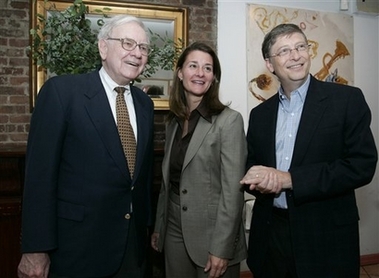
My favorite link on Philippine Economics, Go Figure, ran this piece May 15th,
The biggest charity of them all:
And I made the following comment on that post:
Viola! Two months later, this latest inspiring news hits media:
Giving generously, the American way
AMERICAN VIEW BY GERARD BAKER
Because the comparison made with the Ikea owner in the original article highlighted by Go Figure was not really serious with regard to their serious philanthropy mission, this bit of news should make even bigger the already undisputed biggest private philanthropic organization in the world.
It might serve us better to remember the next time we are tempted to gratuitously trash the US, that these two distinguished persons are Americans, too.
And to end on a lighter trivia. It was also reported that Mr. Buffett will bequeath to his children the not too generous sum (according to him) of one billion dollars. But as I distinctly recall when Bill Gates just had his first son, he also made a similar announcement. And for how much? His was for a more frugal inheritance, something like 25 million dollars for his son.
If you are still conscious and alert, just remember that to a rich man those mentioned amounts are like the way we ordinary mortals value a 100 or a 1000 dollars.

My favorite link on Philippine Economics, Go Figure, ran this piece May 15th,
The biggest charity of them all:
I thought the biggest charity would by far be the Bill and Melinda Gates Foundation. It's certainly the most famous. But The Economist found the biggest of them all - the Stickting Ingka Foundation.
The what? Amazingly, it's the nonprofit foundation that operates all the Ikea stores.
And I made the following comment on that post:
I'm a bit sad. I have always promoted and extolled the altruism of Bill Gates through his gargantuan foundation. This revelation may induce me to write him a letter to recommend that he transfers some of his personal stocks to the foundation, so he can get back to having the world's biggest philanthropic foundation. What's another 10B dollars out of a personal fortune of about 60B dollars. HeHeHe.
Viola! Two months later, this latest inspiring news hits media:
Giving generously, the American way
AMERICAN VIEW BY GERARD BAKER
It was this last device that was most noticeable in the letter he sent this week to the Bill and Melinda Gates Foundation. In it he pledges an initial "material" contribution of shares in his investment company worth about $1.5 billion (£824 million) and then adds that over the next few years he expects those contributions to reach an "eventually substantial" sum. I suppose that only in the small world occupied by Bill Gates and Warren Buffett could a personal gift not be considered "substantial" until it rises well above $1.5 billion towards the $30 billion the donation is expected to reach.
The generosity of Mr. Buffett puts the Sage of Omaha in a rare class of the greatest American philanthropists in history. In narrow financial terms, and translating large donations and legacies of the past into current purchasing power, it is certainly up there with those of the Carnegies, Rockefellers and Guggenheims. Unlike theirs, Mr. Buffett's generosity is literally self-effacing. The great contributions that wealthy Americans have made to educational, social or cultural betterment, including that of Mr. Gates himself, have usually come at one small but enduring price - eponymity.
For comparison, Unesco, the United Nations Educational, Scientific and Cultural Organisation, distributes about $700 million. In Britain, the Department for International Development channelled about £4.2 billion in aid to less developed countries.
Two American philanthropists alone, in other words, will have contributed more to alleviate poverty and disease than the UN's principal development arm. Between them they will have given a sum amounting to about a third of the entire official UK contribution. (Underscoring mine.)
No other nation on earth has the capacity to produce individuals with the wherewithal and the motivation to extend such generosity.
Although official aid is famously lower in the United States than in most of the industrialised world, Americans are, of course, more inclined to give to charity than is almost any other population. Last year they contributed a little over 2 per cent of their gross domestic product, compared with 0.7 per cent in the UK. Of course the bulk of US giving is directed at domestic needs, much of it in the form of giving to local communities and churches. But that doesn't detract from the sheer scale of American generosity. Why is it so large? Income distribution presumably plays a role. Inequality has risen dramatically in the US in the past 25 years. The top 5 per cent of households made more than 21 per cent of total income in 2003, up from 16 per cent 40 years ago. At the very top, the growth in income has been even more spectacular.
Too much can be made of this. It's often forgotten in debates both inside and outside the US that America has some extremely generous expensive social insurance programmes. Social Security, for example, the public pension system, is actually rather more generous than many in Europe, including Britain's. But there's no denying that in terms of their own perception of their relationship to the State and its role in their lives, Americans are substantially different.
Because the comparison made with the Ikea owner in the original article highlighted by Go Figure was not really serious with regard to their serious philanthropy mission, this bit of news should make even bigger the already undisputed biggest private philanthropic organization in the world.
It might serve us better to remember the next time we are tempted to gratuitously trash the US, that these two distinguished persons are Americans, too.
And to end on a lighter trivia. It was also reported that Mr. Buffett will bequeath to his children the not too generous sum (according to him) of one billion dollars. But as I distinctly recall when Bill Gates just had his first son, he also made a similar announcement. And for how much? His was for a more frugal inheritance, something like 25 million dollars for his son.
If you are still conscious and alert, just remember that to a rich man those mentioned amounts are like the way we ordinary mortals value a 100 or a 1000 dollars.
Saturday, June 24, 2006
Currencies Of The European Union
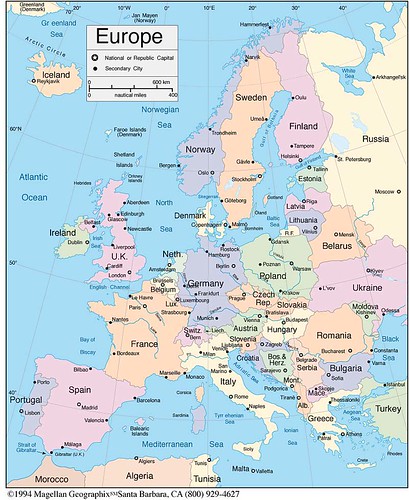
Euros:
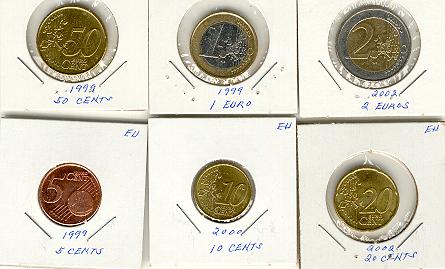
As of this writing there are 25 member states in the European Union (EU) and here is a chronology of when each became a member:
1958: Belgium, France, Germany, Italy, Luxembourg, The Netherlands
1973: Denmark, Ireland, United Kingdom
1981: Greece
1986: Portugal, Spain
1995: Austria, Finland, Sweden
2004: The Czech Republic, Cyprus, Estonia, Hungary, Latvia, Lithuania, Malta, Poland, Slovakia, Slovenia
Possible member candidates:
Croatia, Macedonia, and Turkey
Other Potential Member states:
The remaining states in the Balkans (Albania, Bosnia and Herzegovina, Montenegro and Serbia, including Kosovo)
Those who failed to join or left:
Norway, Greenland, Morocco, and Switzerland.
Other Future Prospects:
Armenia, Cape Verde, Georgia, Iceland, Moldova , and Ukraine
And include the European Microstates:
Liechtenstein, Monaco, and Vatican City
And More:
Macaronesia Region composed of Cape Verde(named above), Azores and Madeira, and Spanish Canary Islands; then, Azerbaijan, Faroe Islands, Iceland, and San Marino.
However, there are only 12 member countries using the EU currency, the euro:
Austria, Belgium, Finland, France, Germany, Greece, Ireland, Italy, Luxembourg, the Netherlands, Portugal and Spain.(Coins and notes were released only on 1 January 2002.)
But the following non-members also use the euro currency: Andorra, the Holy See, Monaco and San Marino.
Click to read more.
Friday, June 23, 2006
In The Blogosphere: Heading For A Fall?
How easily we understand that other people resent the man who seeks to raise himself above them, seeking to appear better and more learned.
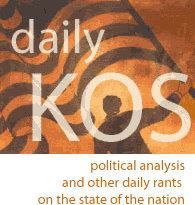
These days media and the blogosphere are causing observable signs of a falling out for a man and his blog, which man has gained prominence and high regard in the blogosphere like no other, in terms of time and circumstance.
And maybe some, including this humble blogger, may have now consequently revisited some earlier disquieting thoughts on how a kind of unwanted metamorphosis has been wrought on this once unassuming and angelic-looking young immigrant from Central America.
Seeing that a good part of your huge and exponentially-increasing firmament though may not unanimously worship you, but at the very least respect and deferentially regard your newly-earned renown and power, installing you, albeit informally, among those who wield power of notice and credibility, such sudden adulation and renown could be a soothing siren song too heady and too strong to disregard or deal with properly.
Others could be dismissive and aver that it is easy for any person, whether weak or strong of character and will, to succumb to the over-powering allures and wiles of fame and fortune, and “to get drunk” with it.
But the initial statement above, extracted from an earlier blog on humility, appears very prescient and apropros.
Now, Markos of Daily Kos may be commencing to feel the discomfiting heat being pushed in front of him. And one can sense some kind of unraveling revelation in the ensuing cavalcade of words thrown out there, for charges and countercharges exchanged, for arguments and ripostes piled on.
One senses an image slowly forming showing that Markos like everybody else has feet of clay, a person with flaws, shortcomings, and maybe one who allows his concupiscence to at times get the better of him.
Spur of the moment words, sentences, ideas, and attitudes that would tend to reveal that he is after all like many of us. Using a vocabulary that at times may be quite pedestrian. Realizing that writing English prose can be more daunting for one using it as a second language, compared to one who may be a native speaker or has it as his primary language. Discerning that our own personal nascent or formed ideas and attitudes may not be as good, as sophisticated, or as logic-proof as the next blog pundit.
This is where the truth and wisdom of humility ought to have played a major role, to preclude in a very real way courting widespread resentment from the people around your firmament, especially coming from those who may have been blessed with more and better talents and capabilities.
Another scathing riposte from the New Republic dated today, June 22nd.
When will it end? Until the fall from grace and respectability?
Thursday, June 15, 2006
Random Prose Scratchings: Of Web Portals and Wall Street Indices
Today, I thought, was deserving of more personal introspection, but away from the flighty spiritual and mystical milieus. More on the mundane scratchings of the daily living of one's life. The daily, at times irksome and plodding, chores required to carry on decently and respectably with the passing vistas that make for the droning workaday life of most earthbound humans. Let us start with:
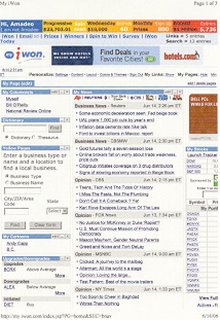 Web Portals
Web Portals
Of course, like most everybody else, you put your pants one leg at a time. But when you boot up that PC and click on your preferred browser, does it automatically bring up a web portal, or a selected personalized homepage?
Time was when web portals were such hot commodities. Netscape easily comes to mind since it pioneered with its proprietary internet browser. Yes, before the now ubiquitous IE. There were then little known web crawlers. But the browsers war was between Netscape and IE. Their duel to the death in a match considered by many as stacked against Netscape ended with IE now undisputedly ruling the roost.
So, is your web portal, MSN now? But there are still choices out there. What about Yahoo! Or might not Google also qualify? It now has so many services, just getting to know it enough boggles the mind. And there are even regional portals.
I know that personal choices are probably as numerous as the stars in the firmament, but in my little world, it has remained static and the same for the last 6-7 years. "Home" to me is a personalized version of iWon, endearingly called My iWon. Tailored to fit my own specific choices and idiosyncratic taste. It even shows the weather condition for the closest place to the old hometown 7,000 miles away.
In a very real way, it defines my person, though in a rather circumspect though still accurate way. My proclivity for science news, my need to track the Wall Street indices in which my puny future hinges on, search services for unfamiliar words, some places to click when needing some humor, and many other "editable" services that one can configure.
Thus, this reflected image of me greets me every time I open my IE browser. And this steady and faithful friend never fails to pique my interest and work me up to a perky disposition.
But, iWon?
Here's what's little is known from Wikipedia:
Which brings me to the next item.
Wall Street/Dow Jones Indices
To the non-business types, I fear that I may as well blabber along about the California slug. And maybe, especially for those outside of the US of A. But not to the millions little guys like me who have hitched our fragile financial futures to the coat-tails of Wall Street, whether in the equities markets, the bonds and other indebtedness markets, commodities/metals markets, etc.
And why so?
To be succinct and to the point, because many of our pension plans, whether company initiated and financed or employee financed, have been invested in the markets of Wall Street in the myriad of plans that have cropped up during these many years.
Thus, the futures of many American workers, whether still actively in the marketplace or retired, hinge on the performances of Wall Street in general. It is estimated that over 70 millions of the labor force are invested into them. Thus, while traditionally Wall Street was limited to the corporate types, the stock broker types, and other white collar professions, it has now also evolved as part of the working man's domain.
Thus, every day or when opportunity allows, I religiously go through the 3 or 4 major indices. And My iWon also allows me to configure my page so it will also show the individual performances of each stock or mutual fund that I am invested in.
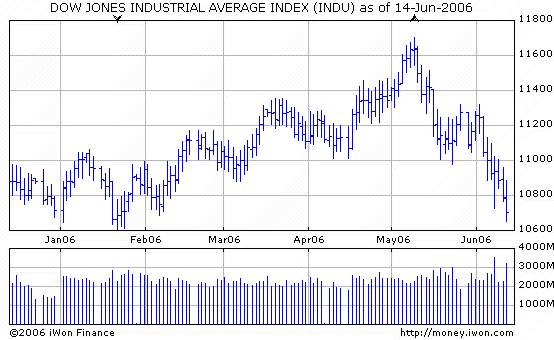
And what's the current short-term prognosis? This little Dow Jones Ind graph above should tell a more revealing story. Just this year alone, it recently went to an all time high close to 12,000, only to drop below 11,000. Now, it hovers on 10,700, losing in the process about 1000 points.
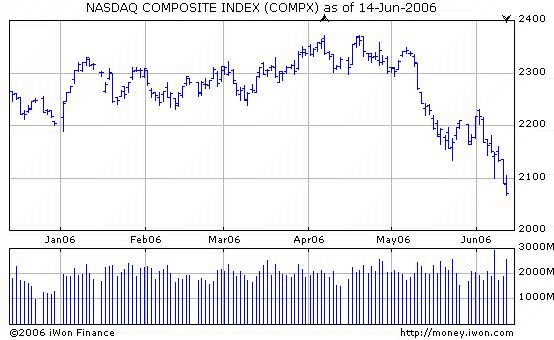
The tech index, Nasdaq, did almost similarly. I am particularly tracking one tech mutual fund I own that shows that at the present time I am showing that its present value is less than all the initial funds that I invested in it, including ploughed-back dividends. And I have held this fund since 1999. A continuing grim reminder of the last tech bust!
But lest anyone get the wrong notions, while the markets have gone south somewhat and temporarily, the US economy overall is going great guns - unemployment is still very low, the labor force continues to grow, productivity continues to improve, inflation continues to be in check amidst continuing fears of an upsurge, reported GDP growth is still commendable, as well as other crucial indicators. All this, amidst continuing costly wars, unprovided expenditures on national security measures against terrorism, and yes, with over 12 million illegal aliens taxing many public services throughout the country.
 Web Portals
Web PortalsOf course, like most everybody else, you put your pants one leg at a time. But when you boot up that PC and click on your preferred browser, does it automatically bring up a web portal, or a selected personalized homepage?
Time was when web portals were such hot commodities. Netscape easily comes to mind since it pioneered with its proprietary internet browser. Yes, before the now ubiquitous IE. There were then little known web crawlers. But the browsers war was between Netscape and IE. Their duel to the death in a match considered by many as stacked against Netscape ended with IE now undisputedly ruling the roost.
So, is your web portal, MSN now? But there are still choices out there. What about Yahoo! Or might not Google also qualify? It now has so many services, just getting to know it enough boggles the mind. And there are even regional portals.
I know that personal choices are probably as numerous as the stars in the firmament, but in my little world, it has remained static and the same for the last 6-7 years. "Home" to me is a personalized version of iWon, endearingly called My iWon. Tailored to fit my own specific choices and idiosyncratic taste. It even shows the weather condition for the closest place to the old hometown 7,000 miles away.
In a very real way, it defines my person, though in a rather circumspect though still accurate way. My proclivity for science news, my need to track the Wall Street indices in which my puny future hinges on, search services for unfamiliar words, some places to click when needing some humor, and many other "editable" services that one can configure.
Thus, this reflected image of me greets me every time I open my IE browser. And this steady and faithful friend never fails to pique my interest and work me up to a perky disposition.
But, iWon?
Here's what's little is known from Wikipedia:
iWon is an Internet portal and search engine that offers users the chance to win money by earning entries in a sweepstakes. Entries are earned by performing the normal tasks performed on the Internet such as using search engines, checking stock quotes, reading email, and keeping up to date on the news.
Among major early backers of iWon was Viacom, parent of CBS and MTV. It is now owned by Barry Diller's InterActive Corporation, parent of the Home Shopping Network, Ask.com, Evite, CitySearch, Ticketmaster, and until recently, travel sites such as Expedia and Hotels.com.
As of March 9, 2006, iWon claimed on its site that it had given away more than $65,667,000 in prizes to more than 268,907 winners.
When Excite@Home went bankrupt in 2001, iWon decided to buy over Excite. They designed a new Excite website and on 16 December 2001, the new Excite was launched.
Some spyware/malware detection programs attempt to limit access to iWon.com because of a program called "Aornum" that was installed for a short time by iWon users with other iWon applications. [1]
Retrieved from "http://en.wikipedia.org/wiki/IWon"
Which brings me to the next item.
Wall Street/Dow Jones Indices
To the non-business types, I fear that I may as well blabber along about the California slug. And maybe, especially for those outside of the US of A. But not to the millions little guys like me who have hitched our fragile financial futures to the coat-tails of Wall Street, whether in the equities markets, the bonds and other indebtedness markets, commodities/metals markets, etc.
And why so?
To be succinct and to the point, because many of our pension plans, whether company initiated and financed or employee financed, have been invested in the markets of Wall Street in the myriad of plans that have cropped up during these many years.
Thus, the futures of many American workers, whether still actively in the marketplace or retired, hinge on the performances of Wall Street in general. It is estimated that over 70 millions of the labor force are invested into them. Thus, while traditionally Wall Street was limited to the corporate types, the stock broker types, and other white collar professions, it has now also evolved as part of the working man's domain.
Thus, every day or when opportunity allows, I religiously go through the 3 or 4 major indices. And My iWon also allows me to configure my page so it will also show the individual performances of each stock or mutual fund that I am invested in.

And what's the current short-term prognosis? This little Dow Jones Ind graph above should tell a more revealing story. Just this year alone, it recently went to an all time high close to 12,000, only to drop below 11,000. Now, it hovers on 10,700, losing in the process about 1000 points.

The tech index, Nasdaq, did almost similarly. I am particularly tracking one tech mutual fund I own that shows that at the present time I am showing that its present value is less than all the initial funds that I invested in it, including ploughed-back dividends. And I have held this fund since 1999. A continuing grim reminder of the last tech bust!
But lest anyone get the wrong notions, while the markets have gone south somewhat and temporarily, the US economy overall is going great guns - unemployment is still very low, the labor force continues to grow, productivity continues to improve, inflation continues to be in check amidst continuing fears of an upsurge, reported GDP growth is still commendable, as well as other crucial indicators. All this, amidst continuing costly wars, unprovided expenditures on national security measures against terrorism, and yes, with over 12 million illegal aliens taxing many public services throughout the country.
Tuesday, June 13, 2006
Humility In Action
 Living life to the fullest and as humanly perfect as possible requires an honest facing of facts. This is the core of the virtue of humility. Facing facts invariably leads to realizing how little one is compared to the rest of humanity and to any higher being.
Living life to the fullest and as humanly perfect as possible requires an honest facing of facts. This is the core of the virtue of humility. Facing facts invariably leads to realizing how little one is compared to the rest of humanity and to any higher being. True humility makes one realize how little he is not only to himself but to everybody else. The lower one reaches into self-esteem, so much the higher he rises to the higher good of truth. The more one attributes any good to himself, the harder he hinders the blessings of virtue to raise him to true perfection.
This is the truth about humility that each one should strive to put into action in daily lives, whether personally interacting or distantly writing about other people.
Nothing is more pleasing than the blessings of peace that true humility brings to our daily lives. One’s fixed attention to this personal nothingness and complete dependence on others or a higher being strips one of the false pretenses of pride that inevitably bring discord and chaos in one’s life.
Think hard about this.
How easily we understand that other people resent the man who seeks to raise himself above them, seeking to appear better and more learned. But no one resents one who appears little before his own eyes. Who does not seek admiration for its own sake, who does not think much what others think of him and thus not solicitous about honors, or human applause. Because he seeks only the higher approbation of goodness and truth.
The truly humble man refuses to defend his rights in unimportant matters. The truly humble man is not afraid or anxious to have others know his faults or correct them. He instead takes these humiliating experiences to show that he is not after earthy temporal glory, but after an improvement of self for the sake of the higher good and truth.
The truly humble man will not also compare himself with those who seem worse than he is. He would rather reflect on his own nothingness and be thankful for the infinite generosity of life he continues to enjoy.
(Adapted ideas from the Bread Of Life.)
Wednesday, June 07, 2006
A Slice Of The Filipino Diaspora – Part II
Continuing on the initial piece on the Filipinos in diaspora here in the West Coast of the US, particularly in the San Francisco-Bay Area of northern California, here is another rich and revealing slice of how the Filipino away from origins continues to exhibit his Filipino-ness, all social and political pressures and nuances notwithstanding.
Pacific Super Grocery: (Click On Images To Enlarge)

Pacific Super - Another View:

Pictured herewith is a place quite well known and frequented by our compatriots, when they shop for their food items. Located in the “newer” side of Daly City, the sector close to famed SerraMonte mall, and where the later houses in Daly City have been built – bigger and more expansive.
These pictures show the Pacific Super grocery store, euphemistically called an ethnic grocery store because it caters to ethnic minorities but in this particular instance more to the FilAms in their predominantly controlled area and city. Ironically, it is owned and operated by Chinese entrepreneurs, uncharacteristically employing Chinese nationals and Hispanics, but no FilAms. Another store location is on the other side of town, which is geographically still part of San Francisco, though patronage-wise, it also caters to the predominantly FilAm areas on that side of town.
Because food and its partaking is such an integral and basic part of one’s Filipino-ness, this grocery store which is located on a strip mall is always a busy beehive of activities by mostly FilAms with Lolo or Lola and little pre-school kids in tow, during most days of the week but most especially during Fridays and/or paydays. It is a place where pesky nostalgia about yearned-for food and food items of the old homeland can be set aside and satisfied, because many of the old familiar items can be found and purchased here. Pan de sal and pan de leche, and even pan de coco wrapped fresh in plastic and baked by FilAm bakers. Popular saltine crackers in tin cans, reminiscent of happy merienda time of the past. Various packets designed to add flavor and local touches to home-cooking menus such as dinuguan, kari-kari, tinola, etc. Fresh tropical fruits such as frying bananas, guavas, mangoes, etc. And what about rice, in its many varieties from as far away and exotic as Thailand and Burma, and as close as the lush farmlands of California with its famous CalRose brand.
And most other necessary items found in a typical Filipino meal setting, though not necessarily imported from the old homeland, since the other Asian neighbors have also gotten wise to this heating lucrative market. Lucrative, because comparatively speaking, many items here, not necessarily imported, sell for far more than comparable items in other grocery stores. For example, a loaf of American bread may have been baked and may weigh similarly to a package of pan de sal, but price-wise, the pan de sal may cost twice as much.
St. Francis Square:

St Francis Square - Another View:
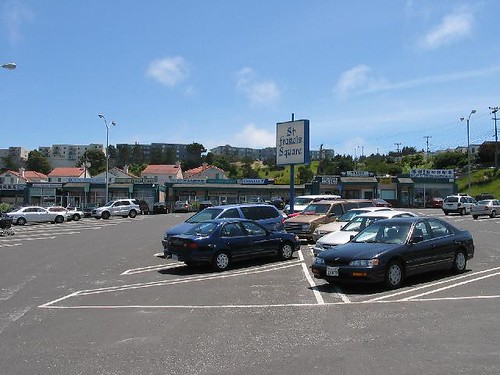
The entire strip mall itself has been abundantly Filipinized. Named St Francis Square, many business tenants are FilAms and I was told when we first chanced upon this mall in the 80’s that the owner of the mall was the late Antonio Villegas, noted former mayor of Manila.
In the pictures, notice Kadoks selling what else, lechon, and other usual short orders. There is a freight forwarding office named Johnny Air. There is even an RCBC office engaged in money remittances and allied services. And next door to Pacific Super is the now homely-looking Tito Rey of the Islands, which used to be the Filipino restaurant and club to go to be noticed by your fun loving away from home compatriots. And where visiting “stars and celebrities” had as their venue of choice for enticing local FilAms to part with their hard-earned dollars to witness them perform, or just simply to see them live and in person. And there are also a number of FilAm mom-and-pop operations behind the front façade and parking lot of the mall.
Notice also on the surrounding hills the confining clusters of both new and not-so-old residential buildings erected close to each other, mute testimony to the scarcity and dearth of land in this part of the land-strapped San Francisco peninsula. You bet most of those houses on higher elevation are owned by our FilAm compatriots.
Pacific Super Grocery: (Click On Images To Enlarge)

Pacific Super - Another View:

Pictured herewith is a place quite well known and frequented by our compatriots, when they shop for their food items. Located in the “newer” side of Daly City, the sector close to famed SerraMonte mall, and where the later houses in Daly City have been built – bigger and more expansive.
These pictures show the Pacific Super grocery store, euphemistically called an ethnic grocery store because it caters to ethnic minorities but in this particular instance more to the FilAms in their predominantly controlled area and city. Ironically, it is owned and operated by Chinese entrepreneurs, uncharacteristically employing Chinese nationals and Hispanics, but no FilAms. Another store location is on the other side of town, which is geographically still part of San Francisco, though patronage-wise, it also caters to the predominantly FilAm areas on that side of town.
Because food and its partaking is such an integral and basic part of one’s Filipino-ness, this grocery store which is located on a strip mall is always a busy beehive of activities by mostly FilAms with Lolo or Lola and little pre-school kids in tow, during most days of the week but most especially during Fridays and/or paydays. It is a place where pesky nostalgia about yearned-for food and food items of the old homeland can be set aside and satisfied, because many of the old familiar items can be found and purchased here. Pan de sal and pan de leche, and even pan de coco wrapped fresh in plastic and baked by FilAm bakers. Popular saltine crackers in tin cans, reminiscent of happy merienda time of the past. Various packets designed to add flavor and local touches to home-cooking menus such as dinuguan, kari-kari, tinola, etc. Fresh tropical fruits such as frying bananas, guavas, mangoes, etc. And what about rice, in its many varieties from as far away and exotic as Thailand and Burma, and as close as the lush farmlands of California with its famous CalRose brand.
And most other necessary items found in a typical Filipino meal setting, though not necessarily imported from the old homeland, since the other Asian neighbors have also gotten wise to this heating lucrative market. Lucrative, because comparatively speaking, many items here, not necessarily imported, sell for far more than comparable items in other grocery stores. For example, a loaf of American bread may have been baked and may weigh similarly to a package of pan de sal, but price-wise, the pan de sal may cost twice as much.
St. Francis Square:

St Francis Square - Another View:

The entire strip mall itself has been abundantly Filipinized. Named St Francis Square, many business tenants are FilAms and I was told when we first chanced upon this mall in the 80’s that the owner of the mall was the late Antonio Villegas, noted former mayor of Manila.
In the pictures, notice Kadoks selling what else, lechon, and other usual short orders. There is a freight forwarding office named Johnny Air. There is even an RCBC office engaged in money remittances and allied services. And next door to Pacific Super is the now homely-looking Tito Rey of the Islands, which used to be the Filipino restaurant and club to go to be noticed by your fun loving away from home compatriots. And where visiting “stars and celebrities” had as their venue of choice for enticing local FilAms to part with their hard-earned dollars to witness them perform, or just simply to see them live and in person. And there are also a number of FilAm mom-and-pop operations behind the front façade and parking lot of the mall.
Notice also on the surrounding hills the confining clusters of both new and not-so-old residential buildings erected close to each other, mute testimony to the scarcity and dearth of land in this part of the land-strapped San Francisco peninsula. You bet most of those houses on higher elevation are owned by our FilAm compatriots.
Subscribe to:
Posts (Atom)
